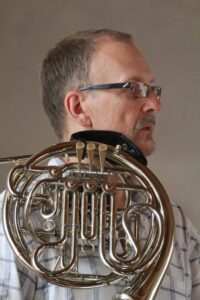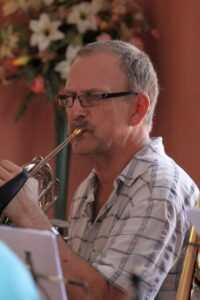
Kaido Otsing, foto autor Kirke Roosaar
Vajadus teha lastele sobivaid lugusid tekkis Kaido Otsingul elust enesest. 1991. aastal algasid suures osas tema initsiatiivil Tartus metsasarvede koosmängu kokkusaamised, millele lisandusid peagi ka koolitused ja meistriklassid. Sellised sündmused kestsid kuni 2005. aastani Tartu Metsasarvepäevade nime all.
Kaaido Otsing: Olin 1989. aastal just alustanud oma esimesi õpilasi õpetama Tartu I Muusikakoolis ja tundsin end õpetajana üsna ebakindlalt. Seetõttu oli külalisprofessoritelt õpetuse saamine meie jaoks hindamatu väärtusega.
Koos sõpradega sõnastasime ühe lause: „Et luua metsasarvemängijaid, tuleb õpetada lastele metsasarvemängu ja oodata, kuni nad suureks kasvavad.” Ning metsasarvemängu õpetamiseks on vaja sobivaid ja jõukohaseid lugusid. Lastele on väga tähtis, MIDA nad mängivad. SEDA väljendab kõige paremini sõnaline informatsioon, mistõttu minu palades on sageli võimalus ise sõnu „luuletada”.
Lugude loomine algas esialgu tuttavate laulude seadmisest metsasarvele. Alles umbes kümme aastat tagasi, kui Jakobi liitus minu „koostööpartnerite“ perre, hakkasin looma originaalteoseid. Hiljem on esmaesitajateks ja inspiratsiooniallikateks saanud ka Juhan ja Mihkel.
Suurematele õpilastele on hästi sobinud teiste heliloojate teosed, kuigi nende hulgas on vähe originaalmuusikat – suurem osa on seaded. Nagu öeldakse: „Õpetada ei saa, saab ainult targemate nõuandjate käest õppida.” Kogu töö tuleb siiski ise ära teha.
Selliseks nõuandjaks olen olnud, vähemalt kahe aasta jooksul 31 noorele muusikule Tartu I Muusikakoolis 1989–2005, EMTA-s 1996–1998 (s.h Tartu filiaalis kuni 2003) ning alates 1998 Elleri-koolis, kus jätkan ka praegu. Lisaks olen tegutsenud suvistel meistrikursustel Võrus alates 1997. aastast, Põltsamaa suvekoolis ja mujal.
Kuna minu esimene amet oli orkestrimuusik (Vanemuise orkester, Läti Riikliku Ooperi- ja Balletiteatri orkester ning Rahvusooper Estonia orkester), usun teadvat, millised omadused ja oskused peavad olema orkestrimängijal. Selles suunas üritan suunata ka kõiki oma „koostööpartnereid“.
Vaata noodivihikute tellimiseks:
Kaido Otsinguga seotud tooted Puhkpillimuusika Koja e-poes

Kaido Otsing, foto autor Kirke Roosaar
The need to create suitable pieces for children arose naturally from real-life experiences. In 1991, French horn ensemble gatherings began quite by chance, soon expanding to include workshops and masterclasses. These events continued under the name Tartu French Horn Days until 2005.
I had just started teaching my first students at Tartu I Music School in 1989 and felt rather uncertain in my role. Having guest professors share their knowledge was therefore invaluable to us.
Together with friends, we came up with a saying: “To create horn players, you have to teach horn playing to children and then wait for them to grow up.” And to teach horn playing, you need appropriate, accessible pieces. For children, WHAT they play is very important. The meaning is best conveyed through words, so my pieces often allow for adding lyrics.
Composing pieces started with arranging familiar songs for French horn. Only about ten years ago, when Jakob joined my “collaborators” family, did I begin creating original works. Juhan and Mihkel later became both the first performers and sources of inspiration for these pieces.
For more advanced students, works by established composers have proven suitable, although there is relatively little original music for them—most consists of arrangements. As wise people say, “You can’t teach; you can only learn from wiser advisors.” Ultimately, all the work must be done by oneself.
I have served as such an advisor to at least 31 young musicians over two years, teaching at Tartu I Music School from 1989 to 2005, the Estonian Academy of Music and Theatre from 1996 to 1998 (including the Tartu branch until 2003), and the Heino Eller Music School since 1998, where I continue today. I have also taught at summer masterclasses in Võru since 1997, Põltsamaa summer school, and similar programs.
My first role was as an orchestral musician (Vanemuine Orchestra, Latvian National Opera and Ballet Theatre Orchestra, and the Estonian National Opera Orchestra). I believe this background has given me a clear sense of the skills and qualities an orchestral player needs, and I aim to guide all my “collaborators” in this direction.
